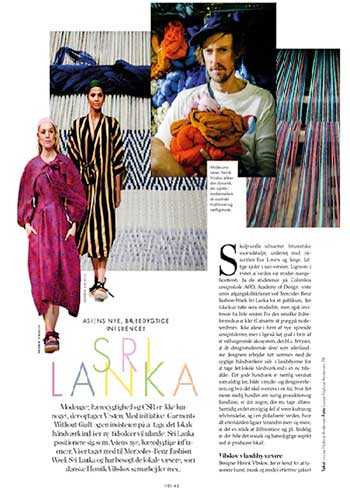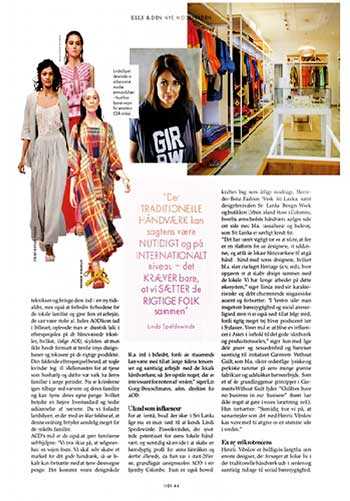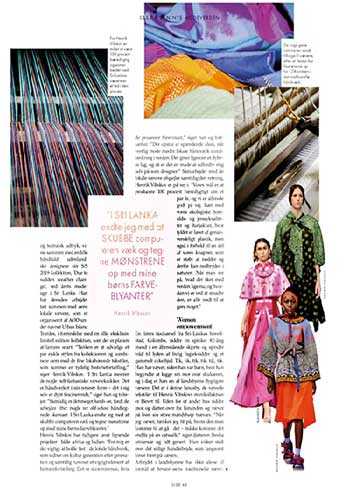Tuesday Dec 23, 2025
Tuesday Dec 23, 2025
Monday, 19 August 2019 00:00 - - {{hitsCtrl.values.hits}}
Fashion weeks, sustainability and CSR are not just something that captivate the West. With the Garments Without Guilt initiative and an insistence on bringing local crafts into a new age, the developing country Sri Lanka will position itself as Asia’s new sustainable influencer. Elle attended Mercedes-Benz Fashion Week Sri Lanka and visited local weavers with whom Danish Henrik Vibskov collaborates

By Louise Nyboe Andersen
Sculptural silhouettes, futuristic sports notes, underwear with the inscription Eco Lovers and long airy dresses in sari version. Just as in the rest of the world, fashion was multi-faceted when the students at the Colombian design school AOD, the Academy of Design, showed their graduation collections at Mercedes-Benz Fashion Week Sri Lanka to an audience not only counting the island’s fashion elite but also people invited from all over world.
Because the beautiful drop-shaped island is ready to make its mark on the fashion world. Not just by presenting new emerging design talents, but also in the form of a well-functioning ecosystem that, among other things, allows the design students as well as foreign designers to work closely with the skilled craftsmen in the villages to take the local craft into a new age. The good craftsmanship is appreciated like never before in fashion and design, and if good craftsmanship is to survive in a business that is mostly about fast production and bottom line, someone has to take action. Traditional crafts are also an important part of our culture and self-understanding, and in a globalised world where everything looks more and more the same, it is a way of differentiating. Finally, there is the whole social and sustainable aspect of producing locally.
Vibskov x village weavers
Designer Henrik Vibskov, who is known for merging art, music and fashion in a slightly goofy and theatrical expression, along with a small handful of other foreign designers showed off his SS19 collection, ‘Due To Sudden Weather Change’, at this year’s Mercedes-Benz Fashion Week in Sri Lanka. He has also worked closely with the island’s local weavers on a small exclusive limited edition collection, organised by AOD under the name Urban Island Textiles, which is scheduled to launch soon: “The idea is to select a few simple styles from the collection and combine them with the fine local woven fabrics, which tells a clear story,” says Henrik Vibskov. “In Sri Lanka, they master some truly amazing weaving techniques. It is the craft in its purest form – it is in itself deeply fascinating,” he says, adding:” At the same time, it is very hands-on, because they work with some pretty old-school hand-drawn methods. In Sri Lanka, I ended up pushing the computer away and drawing patterns with my children’s crayons.”
 Henrik Vibskov has previously done similar projects in both Africa and India: “For me, it is important to stick to the local crafts that testify local culture generation after generation and at the same time showcase an important element of storytelling. It’s scary if these processes disappear,” he says, continuing: “An exciting clash occurs when Western fashion meets local crafts around the world. It just gives a deeper layer, and for me, it is a way to challenge myself as a designer.”
Henrik Vibskov has previously done similar projects in both Africa and India: “For me, it is important to stick to the local crafts that testify local culture generation after generation and at the same time showcase an important element of storytelling. It’s scary if these processes disappear,” he says, continuing: “An exciting clash occurs when Western fashion meets local crafts around the world. It just gives a deeper layer, and for me, it is a way to challenge myself as a designer.”
At the same time, the collaboration with the local weavers reflects the direction in which Henrik Vibskov is heading: “Our goal is to produce 100% sustainable in a couple of years and we’re already on the way. Especially with our organic cotton and jersey qualities and down jackets, where the stuffing is made of recyclable plastic, as well as some of our buttons, which are moulded from nuts and therefore are degradable. When you look at what is happening to the world right now and how we are destroying it, everyone has to do something.”
Women empowerment
An hour’s taxi ride outside of Sri Lanka’s capital Colombo, a skinny 82-year-old man sits in an open shirt, spinning thread on an old bicycle wheel to the sounds of birds chirping. Tap, tap, tap, tap, tap, tap. He has been weaving since he was a child, taught by looking over the shoulder of his mother, and today he is one of the village’s most skilled weavers. It is in this village that the hand-woven fabrics for Henrik Vibskov’s upcoming mini collection have been created.
Outside another house, mother and daughter sit opposite each other, weaving on each of their large, man-made wooden looms. “When I weave, I often think about who’s going to wear it – maybe it will even get on a catwalk,” says daughter Iresha, smiling a bit shy. She takes pride in the neat workmanship that slowly emerges on the loom.
The crafts of the villages not only aim to preserve the island’s traditional handloom techniques and bring them into a new age, but also to improve conditions for the local families and give them a job they can be proud of. Before AOD entered the picture, there was a drastic decrease in demand for hand-woven fabrics, which, according to AOD, was due to the lack of modernising the design and focus on relevant products.
An exciting clash occurs when Western fashion meets local crafts around the world – Henrik Vibskov
The decreasing demand meant that some women went to the Middle East to serve as domestic help and were therefore away from their families for long periods. Now the women are back at the looms and with their families again and can make their own money, which means a higher standard of living and better education for the children. As we leave the village, it is with a strong feeling that this model means the world to the individual families.
AOD’s goal is to make families self-sufficient: “We do not believe that charity is the solution. We need to create a market for the good craftsmanship, so that the locals can continue to make their own money. That’s where our design school comes into the picture because the students can help capture the trends of the time and at the same time work with the local craftsmen, so that something interesting is created for the rest of the world,” says AOD CEO Lin Gong-Deutschmann.
Developing country as influencer
To understand what is happening in Sri Lanka right now, you have to know Linda Speldewinde. The power woman, who spotted the potential of the island’s local craftsmanship and at the same time saw an idea in creating a sustainable profile for the island’s factories, and therefore founded the AOD, the Academy of Design when she was in her early 20s, in her hometown of Colombo.

She is also the main force behind the island’s annual fashion week Mercedes-Benz Fashion Week Sri Lanka, the design festival Sri Lanka Design Festival and the Urban Island retail store in Colombo, from where the island’s best crafts are sold side by side with casual wear and swimwear, for which Sri Lanka is especially known
“It has been important for us to ensure that there is a platform for the designers we educate and to get the local craftsmen to go hand in hand with our designers. This is for example done through the subject of Heritage, where the task is to create designs together with the locals. We have been working on this ecosystem for a long time,” says Linda with her distinctive and deeply charming Sri Lankan accent.
We believe that collaborations like that with Henrik Vibskov can help give us a voice in the world – AOD’s Linda Speldewinde
“In the West, people talk a lot about sustainability and social responsibility, but we also have to follow because a lot of clothes are produced here in South Asia. Our goal is to become an influencer in Asia in relation to the good craftsmanship and the production part,” she says with equal share of power and modesty, while at the same time referring to the initiative Garments Without Guilt, which ensures proper physical and mental working environments at the island’s many green factories and excludes child labour.
As one of the basic principles of Garments Without Guilt reads: Children have no business in our business. She continues: “At the same time, we believe that collaborations like that with Henrik Vibskov can help give us a voice in the world.”
A new micro trend
Fortunately, Henrik Vibskov is far from the only designer trying to keep traditional craftsmanship alive in the world while also contributing to social sustainability. Right now, a micro-trend is emerging, with more and more designers entering into exciting collaborations. Take, for example, Faroese Gudrun & Gudrun, who have given a revival to Faroese knitwear by entering into agreements with the island’s local knitters, but also by collaborating with Jordan and Peru as part of a Women’s Empowerment project.
When you look at what is happening to the world right now and how we are destroying it, everyone has to do something – Henrik Vibskov
Not to mention the Danish knit designer Helga Isager, who has been to India to pass on her knowledge to the local knitters in the KOCO program, Knit One Change One, and will be going again soon to have them produce some of her new designs. The Østerbro-based Sisterjernen, which produces top-quality clothing in its own name, has long had great success with its knitted Tunis hats created by women from Menzel Bourguiba in northern Tunisia. The beanies are part of the Empowerment Through Design project, which aims to give women an income and influence in society.
The same is true of Danish Carcel, who creates the coolest styles in collaboration with incarcerated women in Peru and Thailand, who quickly gained publicity in Vogue and found their way to international webshops such as Net-a-porter and Browns.

Holistic view of life
If we turn our gaze back to Sri Lanka, one question is still pending. How can a developing country be so far ahead in its approach to sustainability? Usually, it is only an area of action that comes to light when the financial foundation is in place. Linda Speldewinde does not doubt for a second: “Our culture certainly plays an important role.
Most of us are Buddhists, and we are used to thinking circularly, opposite to the West, where one often thinks linearly – from A to B. Our view of life is holistic. It’s all connected.”
Back in Copenhagen, it’s time for a status update. After the visit to Sri Lanka, it is clear that we all have a responsibility to support traditional crafts around the world, not least because it helps to strengthen and sustain different cultures, but also because it helps to create better conditions for many families.
And finally: Maybe it’s time to turn our attention to our own craft traditions in fashion and design, because what will separate us from the rest of the world in the future, when globalisation has made us even more similar?
Crafts for which Sri Lanka is knownHandloom
Sri Lanka’s fine weaving technique, which takes place on large wooden looms, creates a firm expression that lends itself well to both clothing and home textiles.
Batik
Batik, which is characterised by its slightly crazed expression, is produced all over the island. A technique where you put wax on the fabric, the place where you do not want colour, but where a fine network of veins still exists where the colour penetrates the wax’s cracks.

Beeralu lace
Beeralu, a form of hand-woven cotton lace, was introduced by the Dutch and the Portuguese during the colonial period. Beeralu is characterised by its intricate and beautiful patterns – often created in white cotton thread. A handwork that takes many hours and is therefore very expensive.
Dumbara
Dumbara is akin to hand weaving, but is characterised by its beautiful geometric patterns, which are achieved by inserting some thin sticks and twisting the thread to create the patterns. A craft that requires a lot of skill and is therefore rare and especially expensive.
Keep an eye on:
The brand Urban Island, which you will soon find in selected stores in Denmark. Urban Island represents the best in Sri Lanka’s craft.
For example, when you buy a tea towel, it is your guarantee that it has been hand-woven in one of the small villages and at the same time helps the local weavers to maintain a reasonable income.